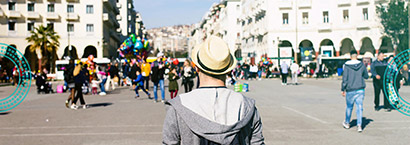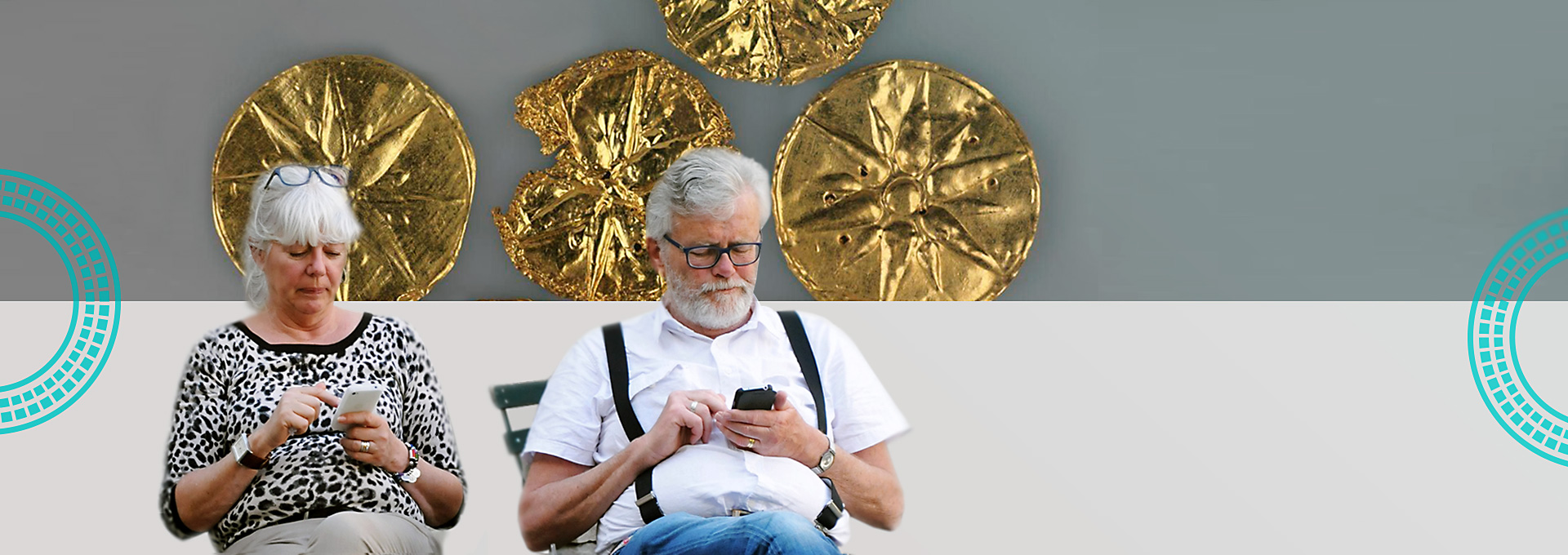Vergina and Pella Day Trip from Thessaloniki
Excursion back in history to the Macedonian Kingdom of Alexander the Great and Philip II
HIGHLIGHTS
- Museum ad Archaeological site of Pella
- Museum of the Royal Tombs and New Museum of Aigai (Vergina)
STARTING POINTS AND DEPARTURE
- Starting point: Aristotle’s Square & Egnatia Street (Venizelos Statue) 08:00
EXCURSION DURATION
- 8 hours and 30 minutes (3 hours on the road)
DESCRIPTION OF THE EXCURSION
We depart to Pella with the bus of Ammon Express along with our friendly trip attendant-archaeologist,
at 08:00 from Aristotle’s Square & Egnatia Street (at the statue of Venizelos).
The distance is about 50 km and lasts about 45’.
We reach Pella, which in the antiquity used to be a port, where we visit the new, modern museum as well as the archaeological site with the unique mosaics. In the archaeological site we can admire the ancient market of the city, the mosaic of the “Abduction of Helen” and the “Amazonomachy” (the battle of Amazons). In the museum, there are exposed objects and artifacts from the daily life of the people; characteristic signs of the lifestyle in the antiquity.
Next, we reach Vergina where we visit the Museum of the Royal Tombs of Aigai, situated in the borders of the village. The characteristic Golden Larnax (funerary casket), an urn with the cremated remains of Phillip II is marked with a 16-rayed sun, the symbol of Macedonia. The Sun of Vergina (or Star of Vergina), which is characteristic symbol of the Argead Dynasty (of the King Phillip II and Alexander the Great) was found together with the excavations that brought back to light his father’s Royal Tomb. 4 of the sun rays represent of the 4 classical elements and the other 12 sun rays represent the 12 Olympian Gods. Admire the golden oak wreath that Phillip II had during his funeral pyre, military armors, various grave goods, the other tombs that were brought back to light and a small sanctuary, the Heroon.
Later, we enjoy our lunch break in a restaurant with greek traditional flavours.
Last stop before our departure is at the grand New Museum of Aigai, hosting findings and artifacts unearthed from the soil of the old capital;
An imposing portrait of Alexander welcomes us and calls us to unravel the roots of History. At the temporary numismatic exhibition you can admire excellent coins coming from every corner of the Hellenistic world, including coinage of the Macedonian kings and Alexander’s successors, while in the following atrium the restored facade of the Palace enlivens in front of your eyes the royal residence of the Macedonian kings and queens. Monumental sculptures, sárissa spears and helmets of the Macedonian phalanx soldiers, banqetuing utensils from the aristocratic symposiums, high-class painted pottery and of course the queen burials with all their jeweleries and royal insignia, are some of the masterpieces retelling you their ancient stories and the amazing history of Agai!
We depart to Thessaloniki at around 15:30p.m and we are back after an hour (around 16:30p.m), making the same stops where we started from.
THE PRICE OF THE EXCURSION INCLUDES
- Round-trip transportation to Vergina and Pella
- English speaking excursion attendant
- Basic travel insurance (during transportation).
- Assistance with the ticket issuance process for anyone who wishes to avoid the queue in the ticket office
NOT INCLUDED
- The entrance fee to the Museum of Vergina (15€ Summer Season / 8€ Winter Season) and to the museum and the archaeological site of Pella (8€ Summer Season / 4€ Winter Season)
- Tour-guide to the museum of Vergina and to the museum and the archaeological site of Pella
- Cost of lunch at the restaurant
- Tips
VERGINA
Aigai was the name of the ancient kingdom of Macedonia. The city was founded by Perdiccas I, the first king of the Macedonians, in the 7th century BC and expanded substantially in the early 5th century BC, when Alexander I was the King of the Macedonian kingdom. At the end of the century, during the reign of Archelaus I, Aigai hosted famous artists and intellectuals of the time, who were inspired and embellished the city with their works. Among them, the painter Zeuxis decorated with beautiful frescoes the royal palace and the tragedian Euripides who composed at Aigai his last tragedies: the “Archelaus” and “Bacchae”.
Philip II, king of the Macedonians, and Aigai during the next century reached the peak of their heyday. The glorious king and father of Alexander the Great called in the palace courtyard intellectuals from all over Greece, and proceeded with the construction of brilliant new buildings that significantly upgraded the aesthetics of the city. Although Pella was proclaimed as the new capital of the Macedonians since the time of King Archelaus I and the great religious festival in honor of Zeus was moved to Dion, Aigai remained the burial place of kings and the place where sacred ceremonies and big celebrations of the Macedonian kingdom took place.
Alexander the Great started from Aigai his campaign in 334 BC to conquest almost all of the known world at the time. The multigold Aigai were also chosen by the great commander as burial place of his murdered father, Philip II, two years earlier, in 336 BC, in a grand funeral ceremony in his honor. Aigai continued to flourish for two more centuries, and continued to be inhabited until after their conquest by the Romans in 168 BC, until it finally falling into the oblivion of time.
The name Vergina was given to the area two millennia later, in 1923, in honor of the legendary Queen Vergina, the last Greek woman governor of the region and offspring of the family of Paleologus before Veria was finally conquested by the Ottomans in 1433. The modern town of Vergina was inhabited by locals and refugees from Asia Minor and Bulgaria, very close to the foundations of the ancient Macedonian kingdom. Under the feet of the new residents, unbeknownst to all, the tomb of one of the greatest kings of Macedonia and of the entire ancient world was hidden among other findings, waiting to come back to light after twenty three centuries.
The historic moment for the world cultural community came in 1977 and 1978 when, during the excavation directed by archeology Professor Manolis Andronikos, first the tomb of Philip II and then the tomb of grandson and his son Alexander the Great, Alexander IV were discovered undisturbed, untouched by any human greedy hands. Both the father and the son of Alexander the Great had a tragic end: Philip was stabbed and Alexander IV was poisoned by usurpers of the throne. Their tombs were left as a legacy in modern times, a sample of the splendor of the era in which they lived both Macedonian kings, rescuing and highlighting the erstwhile glory of the kingdom of ancient Macedonia.
The “Star of Vergina” – the sixteen radii sun and symbol of the Macedonian dynasty – is positioned on the urn containing the cremated remains of Philip II. This is the most exciting finding of the excavations, which continues to this day, and brought to the surface many offerings of gold. Along with the smallest urn the twelve radii star, and the wreaths of oak leaves and fruits. The museum in its current form presents a clever “trick”: the burial buildings are boxed for their protection while they are pointed out, and the hill – the “Great Tumulus” – has been filled with soil so that it looks as it was before the excavations.
The “tomb of Persephone” and a fourth grave that is believed to have belonged to King Antigonus Gonatas, with impressive Doric entrance, are the rest of the tombs in the hill that can be visited, except of Philip II and Alexander IV, which were however looted. The “tomb of Persephone” is decorated with a magnificent fresco on the abduction of Persephone, the goddess Demeter’s daughter, by Hades, the evil god of the Underworld.
UNESCO declared the museum and the archaeological site of Vergina as World Heritage Sites in 1996 including them on the list.
PELLA
The ancient city of Pella “stole” the glory of the city Aigai at the end of the 5th century BC, when the Macedonian King Archelaos I had proclaimed it the new capital of his kingdom. In ancient times, Pella was seaside and was called the “Greatest of Macedonian cities” by the great historian of antiquity Xenophon. In the years of King Philip II, the city continued to flourish, reaching its peak in the years of Alexander the Great, who made the brilliant capital of his kingdom known through his conquests throughout the world known at that time.
Pella remained the capital of the Macedonian kingdom until it was destroyed by the Romans, and then the capital was looted and its treasures were transferred to Rome. In the modern museum of Pella, which was inaugurated in 2009, there are on display many objects from the private and public life of the people of ancient Pella, from their religious buildings and their burial sites, as well as exquisite floor mosaics.
The two most impressive of them, the mosaic of deer hunting and the mosaic with the kidnapping of Eleni by Theseus – the largest till today known mosaic depiction in Greece – are located in the archaeological site, at the spot where they were found, and are open to the public during the summer.
- Our trip attendant-archaeologist shall wear clothing with the Ammon Express marking so that he/she will be recognisable easily
- You should be at the departure point 10΄ before the time indicated in the schedule. The bus cannot remain at designated stops, except for boarding
- Free of charge entrance for children and young people up to the age of 25, from EU member-states, upon presentation of their ID card or passport for verification of their age and country of origin
- Free of charge entrance for children up to the age of 5, from non-European Union countries, upon presentation of their passport for verification of their age and country of origin
- Reduced entrance fee (-50%) is valid for Children and young people aged between 6 and 25 years, from non-European Union countries, upon presentation of their passport for verification of their age and country of origin.
- Reduced entrance fee (-50%) is valid also for Senior citizens over 65 from Greece or other EU member-states and the European Economic Area, upon presentation of their ID card or passport for verification of their age and country of origin.
- In winter season, 01/11 – 31/03, the general entrance fee to the museum of Vergina is 8€ and to the archaeological site and museum of Pella is 4€
- Wear comfortable shoes to walk around the archaeological sights
- In summer season bear in mind to have sunglasses, sunscreen and a hat
- Please be consistent with the exact appointment times specified by the Ammon Express escort, so that the excursion will remain unforgettable to all participants
- Have a nice trip and an unforgettable experience!
- Don’t forget to share pictures and comments from your experience!




















































